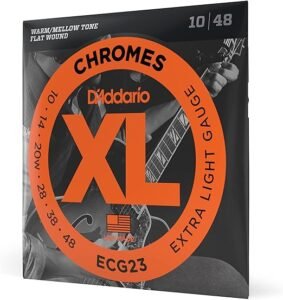Hey there! If you don’t like reading a lot and want to know quickly what string gauge is best for you, use this magic string Gauge finder below. Note: It only works for electric and Bass guitars.
String Gauge Finder
Your ideal string gauge is:
Understanding the significance of string gauges is essential for maximizing your instrument’s potential. The right string gauge can make your instrument more enjoyable to play and significantly affect your tone.
Selecting the right guitar strings involves considering your playing style, instrument, preferred genre, and personal taste. Experimenting with different string gauges is often the best way to find the perfect match for your guitar
What is the String Gauge?
String gauge refers to the thickness of your guitar strings. Different guitars have strings that can be really thin (called super-light) or pretty thick (called heavy). Even though the difference in thickness is small, it changes how the guitar feels and sounds when you play it. Thicker strings need more tightness to sound right and help you play lower notes and the opposite is true for thinner strings.
The string gauge is typically measured in thousandths of an inch, providing precise measurements for different string sets. The high E string, the thinnest string in a set, serves as a reference point for determining string gauges. And this is technically the meaning of the number(s) you see on string sets.
To describe string sets, various terms are used, including super light, light, medium, and heavy. Super light gauge strings have thinner diameters, while heavy gauge strings are thicker. The choice of string gauge affects the tension, playability, and tone of your guitar.
Electric Guitar String Gauges
Electric guitars commonly use 9-gauge and 10-gauge string sets. These gauges strike a balance between playability and tone for most players. However, it’s important to consider the preferences of specific guitar brands. For instance, Fender guitars often come from the factory with 9-gauge strings, while Gibson and Epiphone guitars tend to be equipped with 10-gauge strings.
Within each gauge, there are variations such as super light, light, medium, and heavy string sets. These variations allow you to fine-tune the tension and feel of your guitar. Additionally, if you play a 7-string or 8-string guitar, there are specific string sets available to accommodate the extended range of these instruments.
Electric Guitar String Gauge Cheat Sheet
| Gauge | Suitability | Pros | Cons |
|---|---|---|---|
| Super Light (9-42) | Bending, Soloing, Light Strumming | Easier bending, less finger fatigue | May lack sustain and low-end response |
| Light (10-46) | Versatile, All-around Playing | Balanced tone, good for most playing styles | May require more finger strength for bending compared to super light gauge |
| Medium (11-49) | Rhythm Playing, Blues, Rock | Fuller sound, stronger attack | Requires more finger pressure, may be less comfortable for beginners |
| Heavy (12-54) | Dropped Tunings, Metal, Heavy Riffs | Tighter feel, better for lower tunings | Requires significant finger strength, may feel stiff for some players |
What String Gauges Are Ideal for Guitar Down-Tuning?
For guitarists looking to explore down-tuning, heavier gauge strings, such as 11s or 12s, are often preferred. They help maintain tension and clarity, even in lower tunings. The exact gauge can vary based on how far you intend to down-tune your guitar
Which Guitar Strings Offer the Most Comfort?
The most comfortable guitar strings, particularly for beginners or lead players, are usually lighter gauges like 9s or 10s. These strings are easier on the fingers, making fretting and bending more manageable
Ernie Ball’s Super Slinky .9 string set offers a great option for guitarists looking for light and comfortable strings

D’Addario’s ECG23 XL chrome-plated very light (.010-.048) offers another good option for guitarists looking for a light gauge.
Are 9 Gauge Strings Suitable for Guitar Beginners?
Absolutely! 9 gauge strings are often recommended for beginners due to their ease of play. They assist in building finger strength and agility, making them an excellent choice for those starting their guitar journey
Do Thicker Guitar Strings Provide a Better Sound?
Thicker guitar strings can produce a fuller and warmer tone with increased sustain. However, ‘better’ sound is subjective and varies according to each guitarist’s preference and style
What Guitar String Gauge Should I Use for My Electric Guitar?
Choosing the right gauge for your electric guitar depends on your playing style. Lighter gauges like 9s or 10s offer versatility, while heavier gauges like 11s or 12s yield a thicker tone
What Guitar Strings Did Stevie Ray Vaughan Prefer?
Stevie Ray Vaughan was known for using heavy gauge strings, typically in the 13-58 range. These thicker strings contributed significantly to his distinct, powerful tone
Should I Choose Thinner or Thicker Guitar Strings?
Your choice between thinner or thicker strings should be based on your playing style and tone preference. Thinner strings are generally easier to play, while thicker strings offer greater projection and sustain
What Makes Heavier Gauge Guitar Strings Challenging to Play?
Heavier gauge strings (such as 13s or higher) present a challenge due to their increased tension. They require more finger strength to play and are generally not the best choice for beginners
Bass Guitar String Gauges
The choice of string gauge can significantly impact the tone and playability of your bass. Lighter gauge strings (e.g., 45-100) tend to provide a brighter and more responsive tone with less tension, making them suitable for fast playing and slapping techniques. On the other hand, heavier gauge strings (e.g., 55-110) offer a thicker and more powerful tone, ideal for players who prefer a deeper and punchier sound.
Your playing style and the genre of music you play also play a role in determining the best string gauge for your bass. If you play predominantly with a pick and require a strong attack, you may opt for a heavier gauge. Conversely, if you prefer fingerstyle playing or want to reduce hand fatigue, lighter gauge strings might be more suitable.
The scale length of your bass guitar can also influence the choice of string gauge. Longer scale lengths, such as 34 inches, generally work well with medium to heavy gauge strings, while shorter scale lengths, like 30 inches, may benefit from lighter gauges to maintain proper tension and playability.
Ultimately, finding the ideal string gauge for your bass guitar is a personal preference. It’s worth experimenting with different gauges to discover the tone, feel, and playability that best suit your playing style and musical preferences.
Bass Guitar String Gauge Cheat Sheet
| Gauge | Suitability | Pros | Cons |
|---|---|---|---|
| Extra Light (40-95) | Beginners, Fingerstyle, Light Playing | Easy on the fingers, less finger fatigue | Less low-end depth and sustain |
| Light (45-100) | Versatile, All-around Playing | Balanced tone, good for most playing styles | May lack low-end punch compared to heavier gauges |
| Medium (50-105) | Rock, Pop, Slap Playing | Enhanced low-end response, increased punch | Requires more finger strength compared to lighter gauges |
| Heavy (55-110) | Metal, Heavy Rock, Down-Tuning | Massive low-end presence, improved sustain | Requires significant finger strength, less flexibility |
Acoustic Guitar String Gauges
Acoustic guitars generally require thicker gauge strings compared to electric guitars. The larger body and higher tension of acoustic instruments necessitate the use of heavier strings to produce a full, resonant sound. Standard acoustic guitar string sets typically have a gauge of 12.
Within the acoustic realm, there are variations such as extra light, light, medium, and heavy string sets. These variations allow you to achieve different tones and styles based on your playing preferences. Experimenting with different gauges can help you find the right balance between projection and playability.
Acoustic Guitar String Gauge Cheat Sheet
| Gauge | Suitability | Pros | Cons |
|---|---|---|---|
| Extra Light (10-47) | Beginners, Fingerstyle, Light Strumming | Easy to play, less finger fatigue | Less volume and projection, may lack bass response |
| Light (11-52) | Versatile, All-around Playing | Balanced tone, good for most playing styles | May require more finger strength compared to extra light gauge |
| Medium (12-54) | Strumming, Flatpicking, Bluegrass | Fuller sound, stronger projection | Requires more finger pressure, may be less comfortable for beginners |
| Heavy (13-56) | Aggressive Strumming, Resonant Tone | Strong projection, rich bass response | Requires significant finger strength, may be too stiff for some players |
Comparing Thick and Thin Strings
When choosing between thick and thin strings, there are several factors to consider. The scale length of your guitar, such as a Les Paul versus a Stratocaster, can influence the suitability of certain string gauges. Longer scale lengths generally benefit from thicker strings, while shorter scale lengths may work better with lighter gauges.
Playability is another crucial aspect to evaluate. Thin strings are easier to bend and fret, making them suitable for styles that involve extensive string bending and intricate fretwork. Thicker strings provide more resistance and are often favored for their ability to handle aggressive playing and maintain tuning stability, especially when using drop tunings.
Sound differences between thick and thin strings should also be taken into account. Thicker strings tend to produce a fuller, more robust tone, while thinner strings have a brighter and more responsive character. Your preferred music style and personal taste will guide you towards the sound that resonates with you.
Ultimately, personal preference plays a significant role in choosing the right string gauge. Comfort and playability are paramount, so finding a gauge that feels natural in your hands and facilitates your playing style is crucial. Don’t hesitate to experiment with different gauges to discover the perfect fit for you and your guitar.
Choosing the Right String Gauge
To select the appropriate string gauge, prioritize factors such as playability, scale length, tuning stability, and tone. Consider the information presented in the previous sections and evaluate which aspects matter most to you. A summary table comparing the pros and cons of thick and thin strings can help you weigh your options.
Remember, there is no one-size-fits-all solution. It’s essential to find the right balance that suits your playing style, preferences, and the specific characteristics of your guitar. Don’t be afraid to try hybrid sets that combine different gauges for individual strings, as they can offer a tailored approach to address conflicting preferences.
Final Notes
Choosing the right string gauge for your guitar is a personal decision that requires careful consideration. By understanding the significance of string gauges, exploring different options, and taking into account factors like playability, scale length, tuning stability, and tone, you can make an informed choice. Experimentation is key to finding the perfect gauge that enhances your playing experience and brings out the best in your instrument. Enjoy the journey of discovering the vast world of string gauges, and let your creativity soar as you explore new sonic possibilities.







